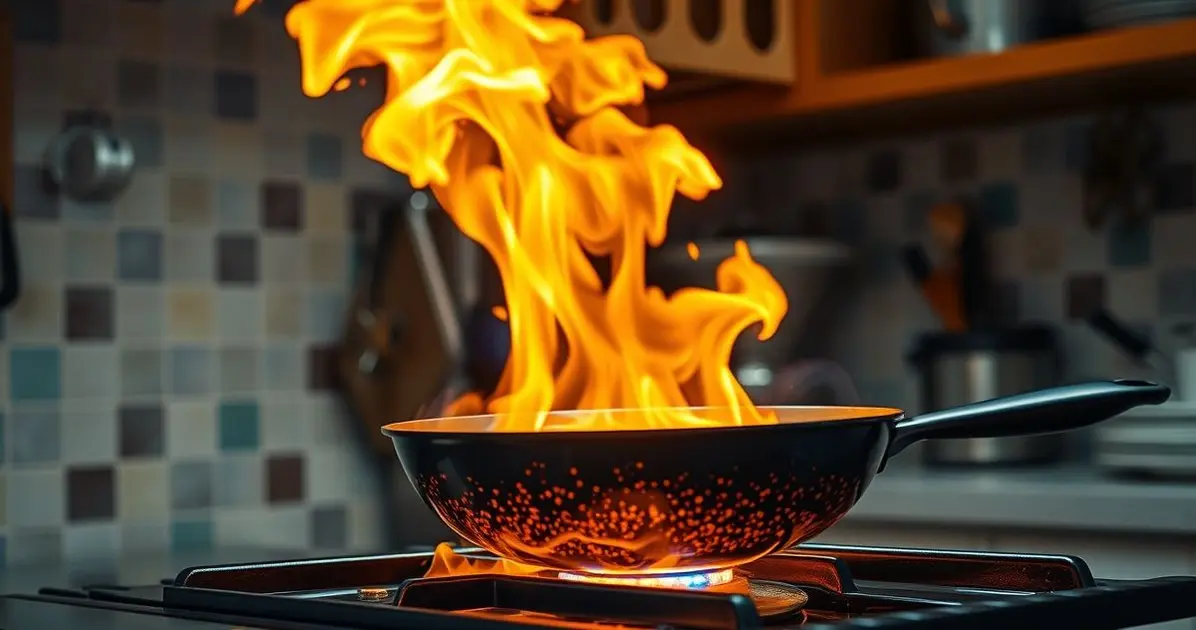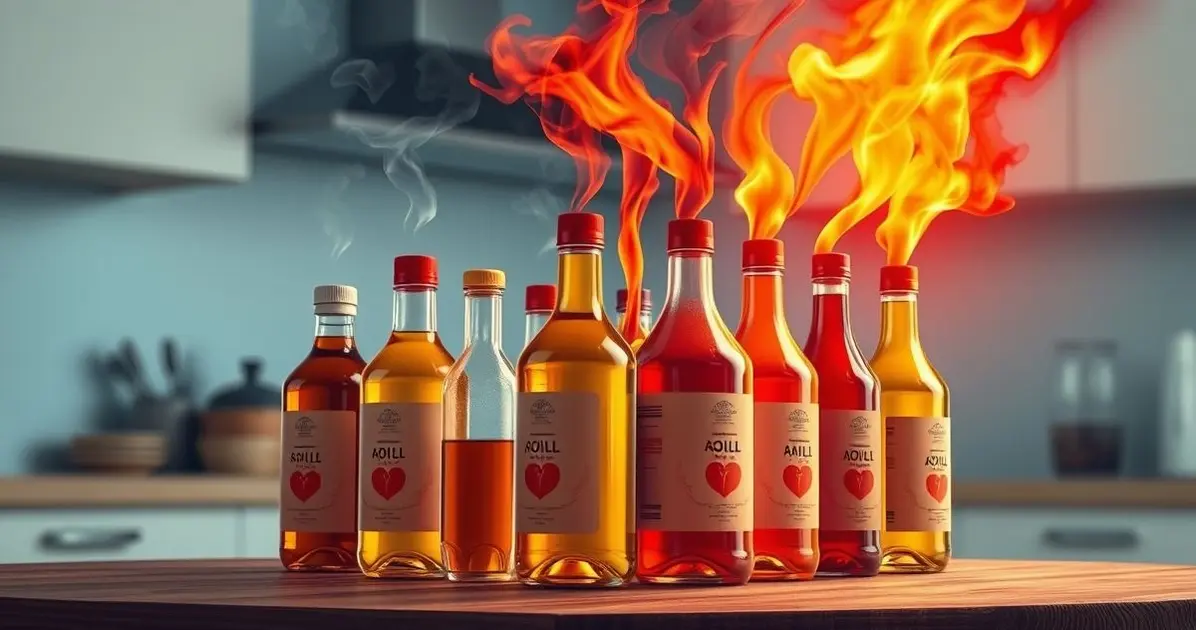Cooking oil can indeed catch fire when it reaches its flash point, especially if overheated. This highlights the need for careful handling and awareness in the kitchen to prevent dangerous flare-ups.
Can cooking oil catch fire

When cooking oil is heated beyond its smoke point, it can ignite and cause a dangerous fire. It’s essential to monitor oil temperature closely and use proper precautions to avoid accidents in the kitchen.
Understanding the Science of Cooking Oil Ignition
Understanding the science of cooking oil ignition is key to preventing kitchen fires and ensuring safety while cooking. When cooking oil is heated, it undergoes a series of changes that can lead to ignition if not monitored properly.
Every type of cooking oil has a specific temperature known as the smoke point. This is the temperature at which the oil begins to break down, producing visible smoke and releasing combustible vapors. These vapors are flammable and can ignite if they come into contact with an open flame or a hot surface.
For instance, oils like extra virgin olive oil have a lower smoke point (around 375°F or 190°C), while oils like avocado oil can withstand higher temperatures (up to 520°F or 271°C). When oil reaches its smoke point, it not only starts to degrade in flavor but also becomes a fire hazard.
Once the oil starts smoking, it indicates that it is producing these flammable vapors. If the temperature continues to rise, these vapors can ignite, leading to a rapid and dangerous fire. This is particularly concerning in cooking methods like frying, where oil is heated to high temperatures.
Additionally, the presence of food particles, moisture, or other contaminants can lower the smoke point of the oil, increasing the risk of ignition. For example, frying foods with residual moisture can cause the oil to splatter and smoke more quickly, creating a hazardous situation.
To summarize, understanding the science behind cooking oil ignition involves recognizing the importance of smoke points, the role of temperature, and the impact of contaminants. By being aware of these factors, cooks can take proactive measures to prevent oil fires and ensure a safe cooking environment.
Factors Influencing the Risk of Oil Fires
Several factors influence the risk of oil fires in the kitchen, and being aware of these can help you take preventive measures while cooking. Here are the key factors to consider:
1. Type of Oil: Different oils have varying smoke points, which is the temperature at which they begin to break down and produce flammable vapors. Oils with lower smoke points, like olive oil and butter, are more prone to ignition than oils with higher smoke points, such as peanut oil or avocado oil.
2. Temperature Control: The temperature at which oil is heated is critical. Heating oil too quickly or leaving it unattended on the stove can lead to it reaching its smoke point without you noticing. Always use a thermometer when frying to maintain the appropriate temperature and avoid overheating.
3. Cooking Method: The cooking method you choose can also affect the risk of oil fires. Deep frying, for example, involves submerging food in hot oil, which can create a higher risk of splattering and ignition. Stir-frying or sautéing at lower temperatures can be safer options.
4. Presence of Food Particles: Food particles left in the oil can lower its smoke point and create a greater risk of ignition. When frying, ensure that the oil is clean and free of debris to minimize the chances of flare-ups.
5. Moisture Content: Introducing moisture into hot oil can cause it to splatter and smoke, increasing the risk of fire. Always dry food thoroughly before adding it to hot oil, and avoid adding frozen foods directly to the fryer.
6. Ventilation: Proper ventilation in your kitchen plays a role in managing smoke and heat. Lack of ventilation can lead to smoke buildup, which may ignite if it reaches a flame. Ensure your kitchen is well-ventilated to disperse any smoke that may occur during cooking.
By understanding these factors that influence the risk of oil fires, you can adopt safer cooking practices and better protect yourself and your kitchen from potential hazards.

Essential Safety Tips for Cooking with Oil
Cooking with oil can be safe and enjoyable if you follow some essential safety tips. Here are key practices to keep in mind while working with oil in the kitchen:
1. Know Your Oil’s Smoke Point: Familiarize yourself with the smoke points of the oils you use. Choose oils with higher smoke points for frying or high-heat cooking, and avoid heating oils beyond their smoke point to prevent ignition.
2. Monitor the Temperature: Use a cooking thermometer to keep track of the oil temperature. This will help you maintain the right cooking temperature and prevent the oil from overheating. If you see smoke, remove the pot from the heat immediately.
3. Avoid Overcrowding the Pan: When frying, avoid adding too much food to the pan at once. Overcrowding can cause the oil temperature to drop, leading to longer cooking times and increased chances of splattering. Fry in small batches for better results.
4. Keep a Lid Nearby: Always have a lid handy when cooking with oil. If a fire occurs, you can quickly cover the pan to suffocate the flames. Never use water to extinguish an oil fire, as this can worsen the situation.
5. Use a Fryer with Safety Features: If you frequently fry foods, consider investing in a deep fryer with safety features such as automatic shut-off and temperature control. These appliances can help minimize the risks associated with frying.
6. Maintain a Clean Cooking Area: Keep your cooking area clean and free from grease buildup. Regularly wipe down surfaces and ensure that any spills are cleaned up promptly to prevent slips and reduce fire hazards.
7. Stay Focused: Never leave hot oil unattended on the stove. Cooking requires your full attention, so stay nearby to monitor the oil and react quickly if something goes wrong.
By following these essential safety tips, you can enjoy cooking with oil while minimizing the risks of fire and ensuring a safer kitchen environment.
What to Do in Case of an Oil Fire
In the unfortunate event of an oil fire, knowing what to do can make all the difference. Here are crucial steps to take if you find yourself facing an oil fire in the kitchen:
1. Stay Calm: The first step is to remain calm. Panic can lead to poor decision-making, so take a deep breath and assess the situation.
2. Turn Off the Heat: If it is safe to do so, turn off the burner or heat source immediately. This will help prevent the fire from getting worse.
3. Cover the Fire with a Lid: If the fire is small and contained in a pan, carefully slide a metal lid over the pan to suffocate the flames. This will cut off the oxygen supply and help extinguish the fire. Make sure to use a lid that fits securely.
4. Use a Class K Fire Extinguisher: If the fire is larger and cannot be controlled with a lid, use a Class K fire extinguisher, which is specifically designed for grease fires. Aim the extinguisher at the base of the fire and sweep side to side until the flames are extinguished.
5. Do Not Use Water: Never pour water on an oil fire. Water can cause the burning oil to splatter and spread the fire, making the situation much worse. This is one of the most critical things to remember.
6. Evacuate and Call for Help: If the fire is out of control or you are unable to extinguish it, evacuate everyone from the kitchen and call emergency services immediately. Do not attempt to fight a large fire if you feel unsafe.
7. Assess the Damage: Once the fire is extinguished and it is safe to return, assess the damage. Check for any lingering odors or smoke and ventilate the area by opening windows and doors.
By following these steps, you can effectively respond to an oil fire and minimize the risk of injury or damage. Always prioritize safety and be prepared to call for help if necessary.
Conclusion
In conclusion, understanding the risks associated with cooking oil is essential for ensuring safety in the kitchen. Cooking oil can indeed catch fire, but by being aware of the science behind oil ignition and the factors that influence fire risks, you can take proactive measures to prevent accidents.
Implementing essential safety tips, such as knowing the smoke points of different oils, monitoring temperatures, and keeping a lid nearby, can significantly reduce the chances of an oil fire. Additionally, knowing how to respond effectively in case of an oil fire is crucial for protecting yourself and your home.
By following the guidelines outlined in this article, you can enjoy your culinary adventures with confidence, knowing that you are taking the necessary precautions to keep your kitchen safe. Stay informed, stay prepared, and happy cooking!
FAQ – Frequently Asked Questions about Cooking Oil Safety
Can cooking oil catch fire?
Yes, cooking oil can catch fire when heated beyond its smoke point, producing flammable vapors.
What is the smoke point of cooking oil?
The smoke point is the temperature at which cooking oil begins to break down and produce smoke and combustible vapors.
What factors influence the risk of oil fires?
Factors include the type of oil, temperature control, cooking methods, presence of food particles, moisture content, and ventilation.
What should I do if an oil fire occurs?
Turn off the heat, cover the fire with a lid, use a Class K fire extinguisher, and never use water to extinguish an oil fire.
How can I prevent oil fires while cooking?
Prevent oil fires by monitoring oil temperatures, knowing smoke points, avoiding overcrowding pans, and keeping a lid nearby.
What type of fire extinguisher is best for oil fires?
A Class K fire extinguisher is specifically designed for grease and oil fires and is the best option for kitchen use.
See more
Discover plenty of easy and delicious recipes you can make at home, from hearty dinners to indulgent desserts and wholesome breakfasts.




